|
At the New York World's Fair 1939-1940,
the United States and the Soviet Union found themselves involved
in a space race. "Having the tallest building at the fair
is apparently important to the national egos of leading world
powers," wrote the New York Times, and both nations vied
for the title of biggest exhibitor at the Fair. The Soviet Union's
pavilion originally beat out the United States and all other
nations with the tallest structure at 188 feet. To recoup, two
flagpoles with the Stars and Stripes were erected a little higher
than the Soviet building. In response, the Soviets planned to
erect a statue of Stalin atop their pavilion, but the Fair would
not allow it. Instead, the Soviets put up a statue of a worker,
whom many thought resembled Stalin, adding an additional 75 feet
to the top of the pavilion and bringing it to a grand total of
267 feet. The United States then added an American flag to the
top of the parachute jump, boosting America to 270 feet in the
air, putting the Soviet Union in its place and winning the space
race.72 The quest
for architectural dominance at the 1964 Fair was not expected
to proceed any differently than in 1939, especially with increased
tension between the United States and the Soviet Union. In fact,
many foreign exhibitors' pavilions and much of the Fair's landscape
were affected by the political climate of the early sixties.
The Soviet Union's plan for a 78,000 square-foot
pavilion, more than a third larger than the maximum limit for
any pavilion at the Fair, was expected to be a major focal point
of the 1964 Fair, so much so that it intimidated other Eastern
bloc countries from participating. William A. Crawford, American
Minister in Romania, wrote to the State Department regarding
Romania's refusal of participation: "The Soviet Union itself
plans to put on a tremendous show at New York… and anything
the other bloc states decided to undertake would presumably pale
by comparison. In effect, the Soviets…have determined to
monopolize the bloc show." Indeed, even Poland, which had
been indicating for some time that it would participate in the
Fair, dropped out for this reason.73
The prospect of another huge Soviet building
inspired US planners. "You can be very well assured that
in 1964 Russia will not have the highest building at the fair,"
said one US Fair official.74
But with a delay in Congress on appropriations for a Federal
Pavilion combined with a nationwide lack of support for the Fair,
the hope of beating the Soviets in 1964 was in peril. Senator
Jacob Javits used the Soviet aspirations to dominate the Fair
as a way of pressing for Congressional action on the funds for
a United States Pavilion. Javits spoke on the floor of Congress
in 1962.
By our own inability to get our
own planning for a US pavilion off the ground, we are virtually
giving the Soviet Union a head start in preparing its exhibit
to be seen by millions of Fair visitors from all over the world.
With only twenty months remaining for the opening of the Fair,
it may be impossible to overcome such a lead if we do not act
promptly….There may be some red faces if the World's Fair
opens in April 1964 with a Soviet pavilion ready for visitors,
and a US pavilion still under construction.…The responsibility
will rest with us here in the Congress, and with the unfortunate
and embarrassing differences now pending between these two bodies
on appropriations. I believe this is just one example of the
consequences caused by the current logjam - and probably one
of the worst…75
Robert Moses was not pleased with the use
of the Fair as a mechanism in Javits' political agenda. Javits
took on the Fair as a personal crusade towards ironing out appropriations
controversies in Congress, and as a New York senator he often
adopted the Fair as his own example of working towards Peace
Through Understanding and a lovable New York. Moses worked
hard to keep the Fair out of internal US politics when those
politics belonged to people or groups over which he had little
power. The State Department was one group that he did not like
to rely on for favors if possible, and politicians were another.
Javits' help only hurt Moses's ego. Moses publicly argued with
Javits' speech and even complimented Federal Pavilion planners
on the progress they were making.76 Still Javits was able to make waves in Congress
as an advocate of a Federal Pavilion. Although the Soviet Union
dropped out of the Fair shortly afterward, the Federal Pavilion's
funding had been secured and space reserved to make it the largest
pavilion of the Fair.
Politics not only affected the size of
pavilions; it also affected the actual placement of pavilions.
The first Asian country to sign up for the Fair was Indonesia,
responding only four days after receiving the invitation. According
to the Announcement of the Information Minister, "The participation
of Indonesia…is in the course of the realization of the
ideals of the Indonesian Revolution in the international field
with the purpose for concluding good friendships between the
Republic of Indonesia and all world nations…."77 President Sukarno requested that his pavilion
be "dramatically placed" between those of the United
States and the Soviet Union, to represent Indonesia's neutrality
in the Cold War.78
For six months, Indonesia rejected site offers for their failure
to be equidistant enough to suit his neutral sentiments.79 Finally Sukarno, who came to the US to meet
with President Kennedy on behalf of the Belgrade conference of
non-aligned nations, visited the Fairgrounds to select the location
of the pavilion. Sukarno chose a 40,000 square foot plot, and
Indonesia became the first nation to formally conclude leasing
arrangements with the Fair.80
Architectural rendering of the Pavilion of
Indonesia*
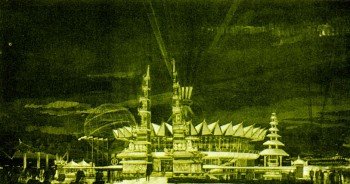 |
Indonesia's Pavilion had a political focus,
reflecting a "desire for creating a synthesis between Western
and Eastern ideologies." It sought to give one an "impression
of what Indonesia regards as its active and independent foreign
policy."81 Sukarno
hand-selected the female guides for the Indonesian Pavilion,
advising them not to "wiggle" like French or American
girls, but to "be Indonesian girls in every one of [their]
actions."82 For Sukarno,
the Indonesia Pavilion's purpose was to function as an expression
of post-colonial independence of nation, ideology and spirit.
Besides choosing the Indonesian girls for
the Pavilion, Sukarno devoted considerable time to planning the
Pavilion itself. He was a painter, an art enthusiast and a jewel
collector, and he put together displays of his personal items
for the Fair. Sukarno was also an engineer, and actually helped
plan the design of the building. His aides recalled that many
times they would approach him with a matter of importance "and
find him so intent on his blueprints for the Fair pavilion that
they could scarcely get his attention."83 Unfortunately, Sukarno would never see the
final product in person.
Outside of the Fair, the cordiality of
relations between the United States and Indonesia began to deteriorate.
The IAE designated May 16, 1964 as "Indonesia Day."
Sukarno had been invited to attend the festivities, but Washington
advised him that American sentiments towards him were hostile
after Indonesia had made attacks on American foreign policy.
Sukarno announced he would not be attending the Fair, giving
as his reason the "Current Malaysia-Indonesia Dispute."
He sent a deputy in his place.84
Although Indonesia withdrew from the United
Nations in January of 1965, Sukarno indicated that Indonesia
would continue to exhibit at the Fair for the second season.
By February of that year, however, the prospect was looking slim.
Several offenses to the United States in Indonesia, including
attacks on US Information Agency libraries, the boycotting of
American ships, and a slew of "anti-American Communist outrages"
prompted the Johnson Administration to threaten action against
Indonesia. One penalty Johnson considered was shutting down Indonesia's
Fair pavilion, to demonstrate "that the US won't be pushed
around."85
On March 11, Sukarno made an official announcement
of withdrawal from the Fair for the 1965 season. His action was
a protest against American support of the "neo-colonialist
project of Malaysia." The United States had given a $4 million
credit to Malaysia for weapons, an action that, Sukarno said,
mocked the theme of the Fair.86
The Fair seized the Pavilion and barred any Indonesian officials
from entering the Fairgrounds. The manager of the Indonesian
exhibit, S. Haditirto, was disturbed by the sudden cold shoulder
from the Fair Corporation. "I do not understand," he
said. "It seems that an iron curtain has suddenly descended
between us and the Fair Corporation."87 For the entire second season of the Fair,
the Indonesia Pavilion stood barricaded and vacant.
This photograph of the Indonesia Pavilion appeared
in the 1965 Official Souvenir Book
of the Fair. However, the pavilion remained closed; the entrance
guarded and padlocked during the 1965 Season.*
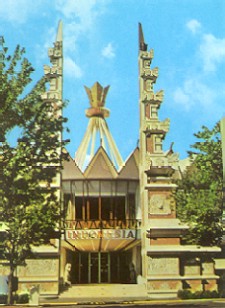 |
Exactly one year after Sukarno pulled his
country out of the Fair, he lost his presidency to a US-backed
anti-Communist military general. Sukarno spent the rest of his
life in house arrest. Indonesia, the first country to join the
Fair, descended into a thirty-year period marked by censorship,
genocide and corruption under the new President Suharto.88 The neutrality that had been so important
in the initial negotiations between Indonesia and the Fair was
all but lost.
West Berlin also had a specific request
for placement at the Fairgrounds. The Fair invited the City of
West Berlin to participate in the Fair independent of the invitation
to West Germany. West Berlin was the only city that was offered
an invitation, and the Fair felt it deserved one "because
of its significance and special status…as an outpost of
the free world."89
Germany did not have its own pavilion at
the Fair because as a member of the BIE, the regulations against
its participation proved to be too difficult for the nation to
bypass. Industries and corporations in Germany did not have the
motivation to come together behind a pavilion at the Fair.90 West Berlin, however, purchased a plot of
10,000 feet for a small pavilion. The site chosen by planners
was on a traffic island next to the United States Pavilion, literally
in the shadow of its protector. The island was initially designated
for landscaping, but the Fair and West Berlin came to a compromise
and assigned the pavilion to a small plot just across the street
from the island and a stone's throw from the United States.91
West Berlin's Pavilion was designed to
reflect the city's encirclement by Communist East Germany. The
Pavilion was topped with a flexible plastic dome and the entrance
was covered by a free-flowing awning. The building was then surrounded
by a concrete wall. Inside, the exhibits, including contemporary
artwork, films about technology and daily life in West Berlin,
and showcases of products made there, represented the "industry,
cultural heritage and future of Germany's free world outpost."92
Other pavilions in the International Area
of the Fair used their exhibits to express their solidarity with
American capitalist ideals or their hope to foster closer ties
with the United States. Sweden, for instance, used its pavilion
to trumpet its commitment to industry and business. The Swedish
Pavilion News, a handout from the Fair, made this point.
When you think of Sweden, think
of one of the world's most expert and successful practitioners
of free enterprise. That's one of the key messages sponsors of
the Swedish Pavilion at the New York World's Fair hope to get
across to the millions of visitors to Flushing Meadow in 1964
and 1965. They cite facts to correct the impressions of those
who mistakenly picture Sweden as excessively oriented toward
statism or "welfare-ism."
The ground floor of the pavilion was dominated
by a miniature version of Sweden's most popular ode to free-enterprise,
the profitable Nordiska Kompaniet department store. 93
Japan's Pavilion "emphasizes the difference
between the new Japan and the old." It had a historical
exhibit about the changes in Japan since U.S. Commodore Matthew
Perry "opened the nation to trade with the West." Items
on display included space rockets and a replica of the world's
largest tanker. Items for sale included color televisions and
motorcycles. To represent the "old Japan," the pavilion
offered demonstrations of floral arrangements, which, "side
by side with some of the world's most advanced microscopes, cameras,
automobiles and industrial machines are charming evidences of
the quiet, cultured but totally nonindustrial Japan of only 100
years ago."94
Architectural model of the Pavilion of Spain.
The Spanish International Pavilion occupied the site formerly
allotted to the USSR..*
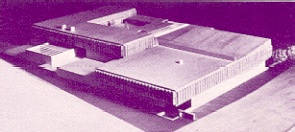 |
Spain's Pavilion was one of the most successful
at the Fair, "the unquestioned hit," according to the
New York Times. It had an extensive contemporary art collection,
and was officially sponsored by Generalissimo Franco's regime.
Negotiations for displays in the pavilion had to be conducted
with Franco himself, something that the US State Department was
wary of. Under no circumstances was the Fair allowed to invite
Franco to the US to visit his pavilion. Said a review in Time,
"Spain, bidding for new status in the conversation of international
trade, has spared no expense to shine at its national best."95 Bruce Nicholson, the IAE liaison to Spain,
recollects in his memoir that "among the reasons Franco
had allowed the Spanish Pavilion to happen at all was the political
one. He wanted closer ties to the United States."96
Another popular pavilion was that of the
Nationalist China. The People's Republic of China was not invited
to the Fair, but Taiwan purchased a large plot and used it to
represent the arts and history of both Taiwan and mainland China,
as well as the economic history of Taiwan in recent years. At
China's groundbreaking, Poletti spoke. "We know that your
country is the bastion of freedom and liberty in a part of the
world that is very precarious, and we feel that your presence
in the International Area of the World's Fair in 1964 and 1965
will serve to cement and strengthen the friendship between the
people of your country and the people of the United States."97
An interesting inclusion in the International
Area of the Fair was the Hall of Free Enterprise. Sponsored by
the American Economic Foundation, the Hall of Free Enterprise's
purpose was to explain through its exhibits "the simple
economic facts of life to millions of people throughout the world,
people who either have had no instruction in basic economic principles
or are victims of false propaganda." On the day of the pavilion's
groundbreaking, Poletti spoke to an audience of Fair officials
and economists.
We are delighted to have the
Hall of Free Enterprise in the International Area, because we
feel the message that this pavilion has to convey is a message
that ought to be heralded throughout the world; it certainly
shouldn't be restricted to our own nation. We know that we cannot
foist our preferred system on other countries, nonetheless we
want to do a lot of boasting and a lot of proclaiming of the
advantages and benefits of our system of free enterprise.
Architectural rendering of the Hall of Free
Enterprise*
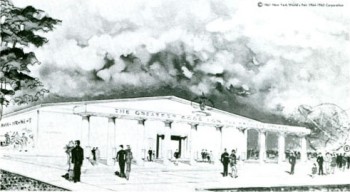 |
The pavilion was a one-story steel and
concrete structure, its front porch aligned by the ten pillars
of economic wisdom, topped by the pavilion's slogan - "The
Greatest Good for the Greatest Number." Inside, a three-dimensional
animated wall panel displayed money flowing through transparent
tubes, while in the theater in the round a production dramatized
"bread and butter issues" regarding production and
consumption. The pavilion also offered two-week economics seminars
for credit towards a Masters degree.
The pavilion that was most pivotal in representing
the ideals of the Fair, which were not so far from American principles,
was the United States Pavilion, a $17 million mammoth of a building
330 feet in length. At the groundbreaking for the United States
Pavilion, President Kennedy spoke of the purpose of such an exhibit
at the World's Fair.
This is going to be a chance
for us in 1964 to show 70 million visitors - not only our countrymen
here in the United States, but people from all over the world
- what kind of people we are….I want the people of the world
to visit this Fair and all the various exhibits of our American
industrial companies and the foreign companies, who are most
welcome, and to come to the American exhibit - the exhibit of
the United States - and see what we have accomplished through
a system of freedom.98
The theme of the glittering square-donut
pavilion was America's "Challenge to Greatness." Inside
were two large exhibit halls, one devoted to the "Challenge
of Freedom," the other devoted to the "Challenge of
a Peaceful World." The first exhibit presented the advantages
and the problems of technological progress for American society.
The second hall depicted America's role in international affairs.
On the second floor, a ride drove visitors past movie screens
featuring moments from American history. "The narration
is straight from This is Your Life, styled in the second
person singular," went a review in Time, "telling
each and every American that you tamed the wilderness,
then you invented the electric light, and you are
now assaulting the universe."99
Pavilion of the United States, New York World's
Fair 1964/1965*
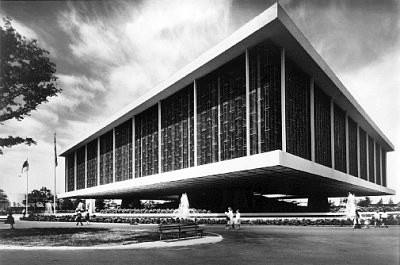 |
The United States pavilion had supreme
dominance over all other pavilions at the Fair as far as size
(it had a plot of more than 100,000 square feet larger than the
next largest pavilion's site) and location (it was located at
the end of the main road radiating from the Unisphere, symbol
of the Fair's theme, Peace Through Understanding).100 Without the presence of the Soviet Union
or any Communist nations at the Fair, nor any physical rival
whatsoever, the United States had no need to worry about any
symbolic challenge from another nation at the Fair.
© Copyright 2005 Sharyn Elise Jackson, All Rights
Reserved.
|